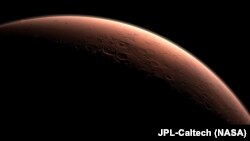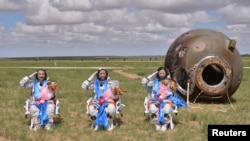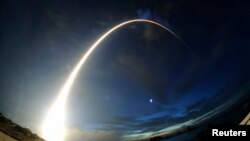India this week successfully launched a spacecraft to Mars. But the launch is not only interesting for the science India’s orbiter hopes to do: studying the Martian atmosphere and mapping surface minerals. It is also is a measure of how much space exploration no longer belongs to the first generation of pioneering space powers: the United States, the Soviet Union/Russia, and the European Union.
Instead, much of the space activity today comes from Asian countries. China, India, Japan, South Korea, and other states are engaged in a space race that in many ways mirrors the leap of the West into space in the mid-20th century.
Frank Morring, senior space technology editor of the U.S.-based magazine "Aviation Week and Space Technology," says “India has had a space program for 40 years and they have made steady progress throughout that time but they haven't really got a lot of attention because they have been trailing behind the 'big boys,' in the old days, the Soviet Union and the United States. Now they have sort of logically got to the point where they can go to Mars. They have already been to the Moon, so more power to them. It looks like they are on their way.”
RFE/RL takes a look at the growing presence of Asia in space, from exploring Mars and the moon, to putting astronauts into orbit.
Exploring Mars
If New Delhi’s Mars orbiter mission succeeds, it will make India the first Asian nation to reach the Red Planet, or any planet.
That would provide a symbolic coup over China, which in 2011 launched its own Mars orbiter, "Yinghuo-1," piggybacking on a Russian spacecraft intended to reach Mars' moon Phobos. But the spacecraft failed to get beyond low-Earth orbit.
It would also be a victory over Japan, whose Mars orbiter mission failed in 2003. Tokyo’s "Nozomi" was launched from Japan in 1998 but was unable to achieve Mars orbit due to electrical failures.
But success is not assured for India’s "Mangalyaan," or "Mars craft” in Hindi. Getting a spacecraft to Mars is one of the riskiest of all space efforts. Only spacecraft sent by the United States, the Soviet Union, and the European Union have reached it safely so far. More than half of all the craft -- 23 out of 40 -- that have tried to reach the Red Planet have failed.
The Moon
Japan sent its "Kaguya" spacecraft to the moon in 2007. It first orbited and studied the moon, then deliberately crashed into its surface in 2009, filming all the way down. The crash made Japan the fourth country or group of countries to reach the lunar surface, following the former Soviet Union, the United States, and the European Space Agency. Tokyo now plans a robotic mission to the moon no earlier than 2016, and a manned mission no earlier than 2020.
India sent its "Chandrayaan-1" orbiter and impact probe to the moon in 2008. The impact probe separated from the orbiter and made a controlled crash into the lunar south pole as the orbiter sought signs of water in the dust cloud. The mission expanded the number of countries that have reached the moon’s surface to five. New Delhi has yet to set a timeframe for its next mission, which it hopes will involve a lunar lander, likely with Russian cooperation.
China has sent two orbiters to the Moon, "Chang'e 1" in 2007 and "Chang'e 2" in 2010, to master the technology for later putting a lunar rover on the surface. The lunar rover mission is scheduled for launch by December 2013 and a manned mission for some time between 2025 and 2030.
South Korea has said it plans to launch a first lunar probe in 2020
Astronauts
Ten years ago, China became the third nation after the Soviet Union/Russia and the United States to independently launch an astronaut into Earth's orbit. In 2008, China made its first space walk and last year it achieved its first manned space docking, an important step in the country's quest to launch a space station by around 2020.
No other Asian nation has yet launched astronauts into orbit.
India has spoken of human space flight as one of its goals but its focus remains on robotic missions. It has ruled out a manned mission before 2017, since that first would require developing a space vehicle capable of carrying astronauts.
The Japanese space agency has said it wants a human spaceflight capability, and has proposed modifying the country's International Space Station cargo delivery system to carry astronauts into orbit by 2025.
Space Stations
China has already embarked on a program to establish a manned space station, starting with the launch of "Tiangong 1" in 2011. The "Tiangong 1" has served as a platform for testing docking procedures and has been visited by both unmanned and manned Chinese spacecraft. With a pressurized habitable volume of only some 15 cubic meters, it is to be replaced over the coming decade by larger "Tiangong-2" and "Tiangong-3" modules.
No other Asian nation currently has the capability to pursue its own space station, leaving China unrivalled in having such a facility. But in the future, it may not be just the other Asian space powers that look enviously at China’s space station plans. So may the United States, Russia, and Europe.
Beijing’s hopes to have a fully operational space station by around 2020, just as the current International Space Station, which is maintained by the three traditional space powers, is expected to cease operation. So far, there are no clear plans for replacement.
Why Are Emerging Countries Exploring Space?
Going into space is expensive and technologically demanding. But emerging countries are making it clear they view space access and exploration as essential, even if funding competes with their other domestic priorities.
Morring of "Aviation Week and Space Technology" says India and China have gone into space for multiple reasons.
“India's space program historically has been intended as a way to bring the benefits of space down to the people of India. They do a lot of telemedicine and distance education using Indian [communications] satellites to reach remote villages because their ground infrastructure is not very advanced," Morring says.
"China does a lot more military space activities than India does and that causes them some problems with the rest of the world, and there also is a prestige element in doing human space flight and that is very important to the Chinese program.”
But there is also a hidden benefit, and that is stimulating education.
Morring notes that when the Soviet Union launched the world’s first satellite -- Sputnik -- in 1957, it set off not just a space race with the United States but huge new interest in both countries in the sciences, mathematics, and engineering.
He says the emerging countries going into space are reaping the same dividends. “India is now certainly benefitting from the technological advances that go along with having a motivated pool of young and innovative engineers,” he says. “And China as well.”
Instead, much of the space activity today comes from Asian countries. China, India, Japan, South Korea, and other states are engaged in a space race that in many ways mirrors the leap of the West into space in the mid-20th century.
Frank Morring, senior space technology editor of the U.S.-based magazine "Aviation Week and Space Technology," says “India has had a space program for 40 years and they have made steady progress throughout that time but they haven't really got a lot of attention because they have been trailing behind the 'big boys,' in the old days, the Soviet Union and the United States. Now they have sort of logically got to the point where they can go to Mars. They have already been to the Moon, so more power to them. It looks like they are on their way.”
RFE/RL takes a look at the growing presence of Asia in space, from exploring Mars and the moon, to putting astronauts into orbit.
Exploring Mars
If New Delhi’s Mars orbiter mission succeeds, it will make India the first Asian nation to reach the Red Planet, or any planet.
That would provide a symbolic coup over China, which in 2011 launched its own Mars orbiter, "Yinghuo-1," piggybacking on a Russian spacecraft intended to reach Mars' moon Phobos. But the spacecraft failed to get beyond low-Earth orbit.
It would also be a victory over Japan, whose Mars orbiter mission failed in 2003. Tokyo’s "Nozomi" was launched from Japan in 1998 but was unable to achieve Mars orbit due to electrical failures.
But success is not assured for India’s "Mangalyaan," or "Mars craft” in Hindi. Getting a spacecraft to Mars is one of the riskiest of all space efforts. Only spacecraft sent by the United States, the Soviet Union, and the European Union have reached it safely so far. More than half of all the craft -- 23 out of 40 -- that have tried to reach the Red Planet have failed.
The Moon
Japan sent its "Kaguya" spacecraft to the moon in 2007. It first orbited and studied the moon, then deliberately crashed into its surface in 2009, filming all the way down. The crash made Japan the fourth country or group of countries to reach the lunar surface, following the former Soviet Union, the United States, and the European Space Agency. Tokyo now plans a robotic mission to the moon no earlier than 2016, and a manned mission no earlier than 2020.
India sent its "Chandrayaan-1" orbiter and impact probe to the moon in 2008. The impact probe separated from the orbiter and made a controlled crash into the lunar south pole as the orbiter sought signs of water in the dust cloud. The mission expanded the number of countries that have reached the moon’s surface to five. New Delhi has yet to set a timeframe for its next mission, which it hopes will involve a lunar lander, likely with Russian cooperation.
China has sent two orbiters to the Moon, "Chang'e 1" in 2007 and "Chang'e 2" in 2010, to master the technology for later putting a lunar rover on the surface. The lunar rover mission is scheduled for launch by December 2013 and a manned mission for some time between 2025 and 2030.
South Korea has said it plans to launch a first lunar probe in 2020
Astronauts
Ten years ago, China became the third nation after the Soviet Union/Russia and the United States to independently launch an astronaut into Earth's orbit. In 2008, China made its first space walk and last year it achieved its first manned space docking, an important step in the country's quest to launch a space station by around 2020.
No other Asian nation has yet launched astronauts into orbit.
India has spoken of human space flight as one of its goals but its focus remains on robotic missions. It has ruled out a manned mission before 2017, since that first would require developing a space vehicle capable of carrying astronauts.
The Japanese space agency has said it wants a human spaceflight capability, and has proposed modifying the country's International Space Station cargo delivery system to carry astronauts into orbit by 2025.
Space Stations
China has already embarked on a program to establish a manned space station, starting with the launch of "Tiangong 1" in 2011. The "Tiangong 1" has served as a platform for testing docking procedures and has been visited by both unmanned and manned Chinese spacecraft. With a pressurized habitable volume of only some 15 cubic meters, it is to be replaced over the coming decade by larger "Tiangong-2" and "Tiangong-3" modules.
No other Asian nation currently has the capability to pursue its own space station, leaving China unrivalled in having such a facility. But in the future, it may not be just the other Asian space powers that look enviously at China’s space station plans. So may the United States, Russia, and Europe.
Beijing’s hopes to have a fully operational space station by around 2020, just as the current International Space Station, which is maintained by the three traditional space powers, is expected to cease operation. So far, there are no clear plans for replacement.
Why Are Emerging Countries Exploring Space?
Going into space is expensive and technologically demanding. But emerging countries are making it clear they view space access and exploration as essential, even if funding competes with their other domestic priorities.
Morring of "Aviation Week and Space Technology" says India and China have gone into space for multiple reasons.
“India's space program historically has been intended as a way to bring the benefits of space down to the people of India. They do a lot of telemedicine and distance education using Indian [communications] satellites to reach remote villages because their ground infrastructure is not very advanced," Morring says.
"China does a lot more military space activities than India does and that causes them some problems with the rest of the world, and there also is a prestige element in doing human space flight and that is very important to the Chinese program.”
But there is also a hidden benefit, and that is stimulating education.
Morring notes that when the Soviet Union launched the world’s first satellite -- Sputnik -- in 1957, it set off not just a space race with the United States but huge new interest in both countries in the sciences, mathematics, and engineering.
He says the emerging countries going into space are reaping the same dividends. “India is now certainly benefitting from the technological advances that go along with having a motivated pool of young and innovative engineers,” he says. “And China as well.”




